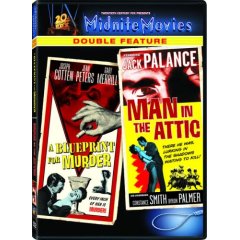Joseph Cotton, having already starred in two of the very greatest films of all time—namely Lady Frankenstein and Latitude Zero*–soon began a steeper than usual career decline that ultimately saw him appearing in fare like The Oscar, White Comanche (opposite William Shatner playing half-breed twins [!]), Baron Blood and other such classics.
[*Or maybe I meant to write Citizen Kane and The Third Man. My notes got messed up. In any case, when a film like Hitchcock’s Shadow of a Doubt doesn’t make your top two, you know you’ve had a good career.]Between those extremes, however, he naturally more often worked the middle ground, as with this programmer. Although often described as a Noir, A Blueprint for Murder is rather more your standard, Hitchcockian-styled suspense yarn. It is, however, a bit of an odd duck.
Like a lot of b-movies from this period, we don’t waste a lot of time getting into things. We start things off with a bang, or at least a wail, as we open on a speeding ambulance. Insistent and melodramatic music booms on the soundtrack as a girl on a stretcher, Polly, is delivered to a hospital.
Soon Polly’s long absent uncle Cam (Cotten) makes an appearance and meets with Lynne, Polly’s step-mother. Cam’s brother is deceased, and Lynne has been raising both Polly and younger brother Doug. (This curly-headed, innocent-eyed lad, given to wearing a suit and tie and shouting “Gosh!” at the drop of a hat, is the element most likely to draw snickers from modern viewers.)
Polly seems to recover, but later relapses and dies. Meanwhile, Cam visits old friend Fred (Gary Merrill, in his second visit to this site in a month), who was also his brother’s lawyer. Fred’s wife Maggie is a pulp writer, and possesses a suitably wild imagination. After hearing that Doug morosely remarked upon the similarity between Polly’s death and that of their father, Maggie notes that their symptoms in common are consistent with strychnine poisoning.
Cam naturally finds the idea fantastic (especially since he has a bit of thing for Lynne), and laughs off the suggestion, as does the family doctor. However, Fred later explains that his brother’s will determines that Lynne will inherit a sizable fortune—a million bucks, which was a pretty hefty sum back in 1953—but only if both of the children should die as well. Cam still finds the idea ridiculous, but accedes to Fred and Maggie’s pleas to force an autopsy.
Naturally, in case the movie’s title doesn’t give it away, Polly does indeed prove to have died of strychnine poisoning, this being about twenty minutes in. The police prove of little help, as poisonings (according to the film, anyway) are notoriously hard to get a conviction for. Cam must now balance his long-standing attraction to Lynne, his growing suspicions that she may be a murderess after all, and the possible danger to Doug.
A Blueprint for Murder has been recently released in a double feature set with the same year’s The Man in the Attic, as part of Fox’s Midnite Movie DVD imprint. Although not appearing so initially, the pairing is canny. Despite the markedly different settings—Man in the Attic is a period piece, set in London during the Jack the Ripper killings—both films revolve around a sympathetic lead character who increasingly fears that a possible love interest may in fact be a vicious murderer.
Each film here (as opposed to the MGM contributions to the Midnite Movie line) gets its own separate disc, and the presentation is pleasingly sharp. This, however, serves to highlight one of the film’s odder qualities, a radical shift in tones. The movie can be split into three acts, with markedly different feels.
The early scenes are quite ‘movie like,’ if you know what I mean, mannered and shot on obvious (if unobtrusive) sets. However, when we move into the police investigation stuff, the film suddenly assumes a shot-on-location, flat documentary style. This style was coming into vogue for police procedurals,* following in the wake of the “Just the facts, Ma’am” naturalism of the Dragnet radio and TV shows. As such, this is the section of the picture that holds up the best sixty-odd years later.
[*Even police procedurals where the killers turn out to be giant ants. See Them!, 1954.]The third act, meanwhile, throws naturalism out the window, as Cotten suddenly begins narrating things via an interior monologue. Between this and the increasingly baroque action, the last section of the movie reminded me a great deal of a radio script loosely adapting into a screenplay. The climax is exciting (if a more than a bit unbelievable), but the brief epilogue is quite weird, as if they had forget to shoot one and just edited a short sequence together to tie things up.
The cast is good, especially Cotten. He has a brisk, intrinsically American no-nonsense quality to him, which is counterpointed with an occasionally whimsical slyness that reminded me a bit of Vincent Price in his earlier, straighter roles.
I really don’t want to knock Fox and MGM for releasing the flood of truly obscure offerings they put out recently, although this stuff is generally only for those interested enough to have sought out more important films first. Basically, if you haven’t seen A Shadow of a Doubt or several other much better films, you probably shouldn’t be watching this.

